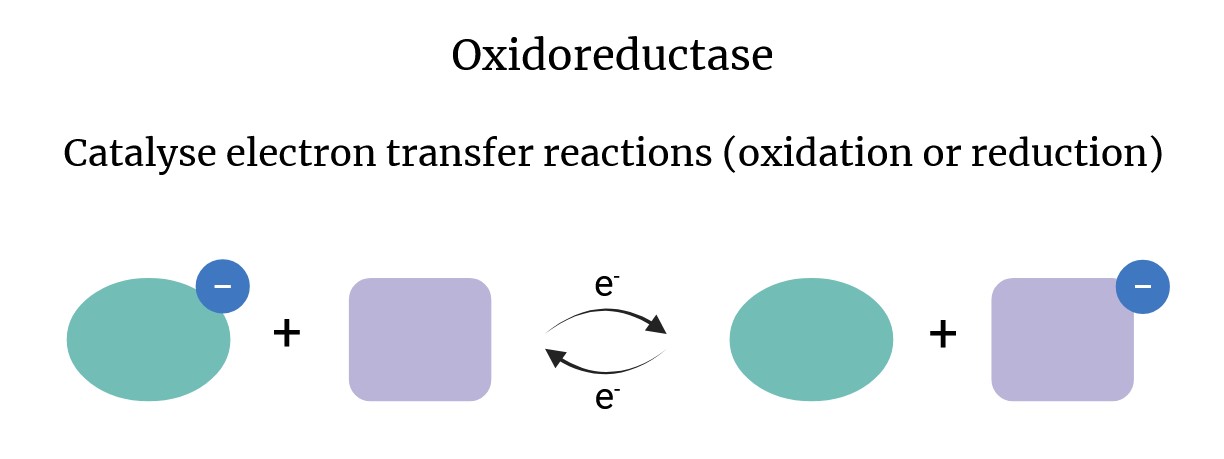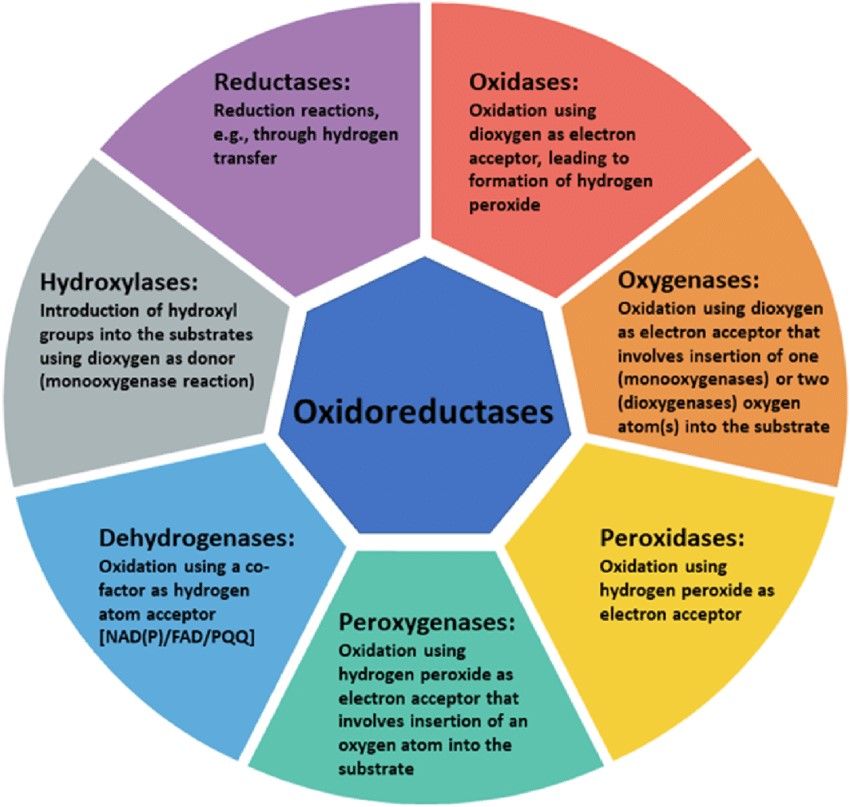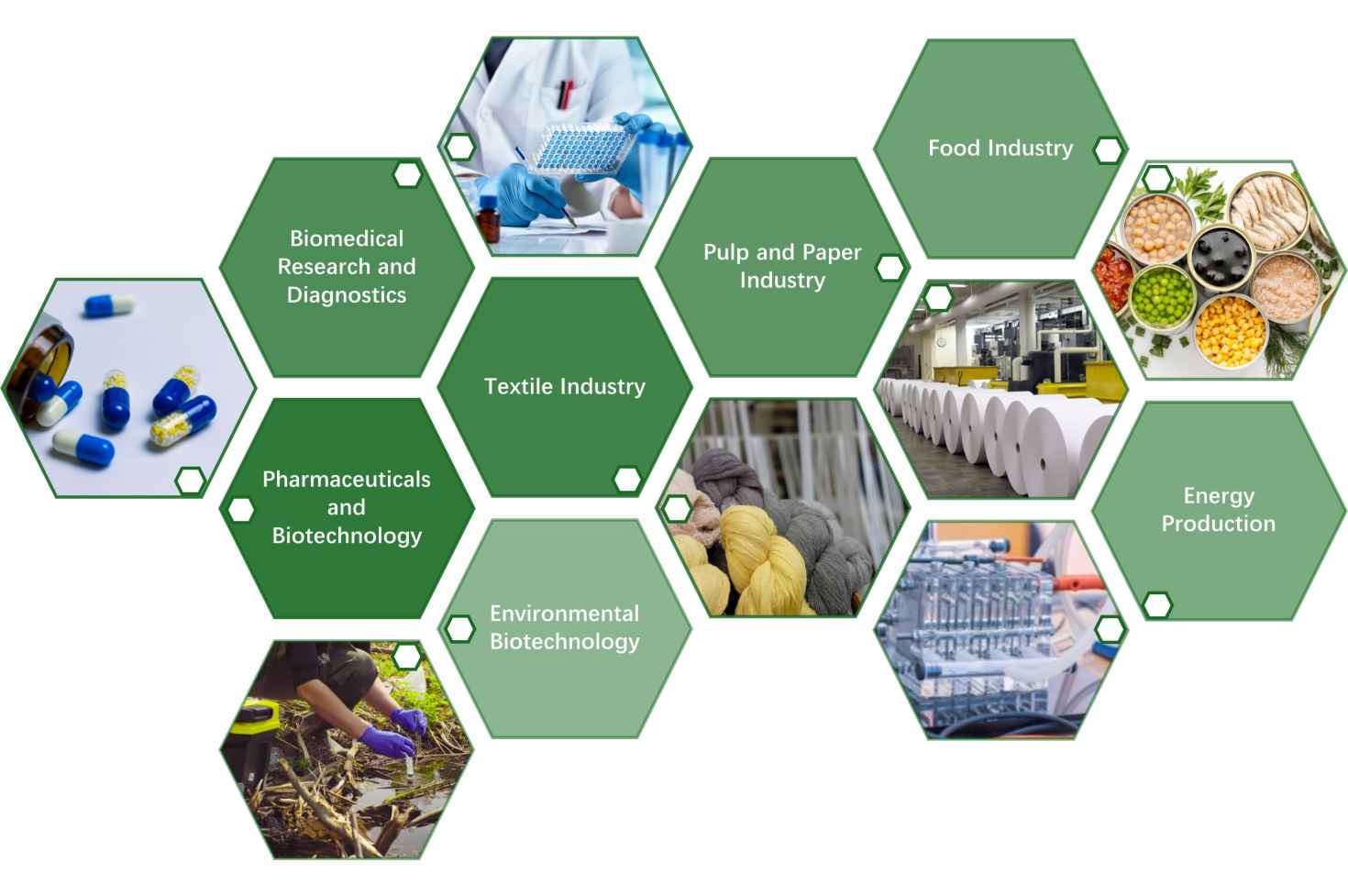Our Products Cannot Be Used As Medicines Directly For Personal Use.


Welcome! For price inquiries, please feel free to contact us through the form on the left side. We will get back to you as soon as possible.
Oxidoreductases
Oxidoreductases are a class of enzymes that catalyze oxidation-reduction (redox) reactions involving the transfer of electrons from one molecule (the reductant) to another (the oxidant). These enzymes are essential for many biological processes, including respiration, photosynthesis, and detoxification. The redox reactions facilitated by oxidoreductases are fundamental to cellular metabolism and energy production, making them indispensable to life. Oxidoreductases have a wide range of applications in research and industry. Creative Enzymes is pleased to offer a comprehensive selection of approximately 450 oxidoreductases, including native Aspergillus sp. glucose oxidase, native bovine catalase, recombinant human 5-lipoxygenase, and more to meet your specific needs.

Oxidoreductases are one of the seven major classes of enzymes classified by the Enzyme Commission (EC). These enzymes play a critical role in redox reactions where they facilitate either the removal of electrons (oxidation) or the addition of electrons (reduction). The general reaction catalyzed by oxidoreductases can be represented as follows:

In this reaction, Ared is the electron donor (reductant), and Box is the electron acceptor (oxidant). The enzyme facilitates the transfer of electrons, leading to the oxidation of Ared to Aox and the reduction of Box to Bred.
Oxidoreductases are classified based on the specific type of redox reaction they catalyze, and the nature of the electron donor and acceptor involved. Oxidoreductases are classified as EC 1 in the Enzyme Commission (EC) numbering system. Oxidoreductases can be further classified into 21 subclasses ranging from EC 1.1 to EC 1.21, including dehydrogenase, oxidase, peroxidase, and oxygenase.
Reactions Catalyzed by Oxidoreductases
The reactions catalyzed by oxidoreductases are diverse and include several important biological processes:
| Reaction | Catalytic Mechanism | Example |
| Dehydrogenation | Dehydrogenases are a subclass of oxidoreductases that remove hydrogen atoms from a substrate and transfer them to an acceptor molecule, typically NAD+ or FAD. | Lactate dehydrogenase catalyzes the conversion of lactate to pyruvate, a key step in cellular respiration. |
| Oxidation | Oxidases are enzymes that transfer electrons from a substrate to molecular oxygen (O2), resulting in the formation of water or hydrogen peroxide. | Glucose oxidase catalyzes the oxidation of glucose to gluconic acid with the simultaneous reduction of oxygen to hydrogen peroxide. |
| Reduction | Reductases are involved in the reduction of substrates by accepting electrons from a donor molecule. | Nitrate reductase catalyzes the reduction of nitrate (NO3-) to nitrite (NO2-) in the nitrogen cycle. |
| Peroxidation | Peroxidases catalyze reactions in which hydrogen peroxide (H2O2) serves as the electron acceptor. | Catalase breaks down hydrogen peroxide into water and oxygen, protecting cells from oxidative damage. |
| Oxygenation | Oxygenases incorporate molecular oxygen into substrates. | Cytochrome P450 involved in the metabolism of drugs and xenobiotics by incorporating an oxygen atom into organic substrates. |
Different Types of Oxidoreductases
Oxidoreductases are divided into several subgroups based on their function and the type of reactions they catalyze. Below are some of the most important enzymes in this class:
Glucose Oxidase
Glucose oxidase is an enzyme that catalyzes the oxidation of glucose to gluconic acid and hydrogen peroxide. It is commonly found in fungi and insects and plays a critical role in glucose metabolism. Glucose oxidase is widely used in biosensors for glucose monitoring, particularly in diabetes management. It is also used in the food industry to remove glucose from egg whites and other products to prevent browning.
Catalase
Catalase is an enzyme that catalyzes the decomposition of hydrogen peroxide into water and oxygen. It is found in almost all living organisms exposed to oxygen. Catalase is used in the textile industry to remove hydrogen peroxide after bleaching (e.g., native thermostable fungi catalase for textile process), in the food industry to preserve food (e.g., native Aspergillus sp. catalase), and in the pharmaceutical industry to protect against oxidative damage (e.g., catalase-crude enzyme).
Lipoxygenase
Lipoxygenase catalyzes the oxidation of polyunsaturated fatty acids, leading to the formation of hydroperoxides. It is found in plants, animals, and fungi (e.g., native glycine max (soybean) lipoxidase, recombinant human 5-lipoxygenase) Lipoxygenase is used in the food industry to improve dough properties in baking and to enhance the flavor of processed foods. It also plays a role in the biosynthesis of signaling molecules such as jasmonic acid in plants.
Laccase
Laccases is a multi-copper oxidase that catalyzes the oxidation of phenolic compounds with the reduction of oxygen to water. It is widely found in fungi and plants (e.g., native Aspergillus sp. laccase, native laccase from white rot fungi, native Rhus vernicifera laccase). Laccase is used in the pulp and paper industry for lignin degradation, in bioremediation to detoxify contaminants, and in the textile industry for dye decolorization. It is also used in biosensors and biofuel cells.
Tyrosinase
Tyrosinase is an enzyme that catalyzes the oxidation of phenols such as tyrosine to produce melanin and other pigments. It is widely distributed in plants, animals, and microorganisms. Tyrosinase is used in the cosmetics industry for skin whitening products, in the food industry to inhibit browning in fruits and vegetables, and in biosensors to detect phenolic compounds.
Oxygenase
Oxygenases are enzymes that incorporate oxygen atoms into substrates. They are divided into dioxygenases, which incorporate both atoms of molecular oxygen, and monooxygenases, which incorporate one atom of oxygen. Oxygenases are used in drug metabolism and detoxification, in the synthesis of hormones and signaling molecules, and in bioremediation to degrade environmental pollutants such as polycyclic aromatic hydrocarbons.
Peroxidase
Peroxidases are a group of enzymes that catalyze the reduction of hydrogen peroxide by various electron donors. They are found in plants, animals, and microorganisms (e.g., native bovine glutathione peroxidase, native Nematoloma frowardii manganese peroxidase, native Bjerkandera adusta peroxidase). Peroxidases are used in diagnostic assays, in bioremediation to degrade pollutants, and in the textile industry for bleaching and dyeing processes. Horseradish peroxidase (HRP) is commonly used in immunoassays and biosensors.
Peroxygenase
Peroxygenases are a group of enzymes that catalyze the insertion of an oxygen atom from hydrogen peroxide (H2O2) into an organic substrate. These enzymes are involved in various oxidation reactions, often generating hydroxylated products. Unlike other oxygenases, peroxygenases do not require molecular oxygen as a co-substrate, relying instead on hydrogen peroxide. Peroxygenases are used in biocatalysis, environmental biotechnology and biomass conversion.
Hydrogenase
Hydrogenases are enzymes that catalyze the reversible oxidation of molecular hydrogen (H2). There are two major types of hydrogenases: [NiFe]-hydrogenases and [FeFe]-hydrogenases, which differ in their active sites. These enzymes play a key role in microbial energy metabolism, especially under anaerobic conditions, by enabling the interconversion of hydrogen gas and protons. In the field of bioenergy, hydrogenases have potential for the development of sustainable hydrogen-based energy systems; in environmental biotechnology for the degradation of environmental pollutants; and in synthetic biology for use in artificial photosynthesis.
Dehydrogenase
Dehydrogenases are enzymes that catalyze the removal of hydrogen atoms from a substrate, usually by transferring them to an electron acceptor such as NAD+(e.g., native Leuconostoc mesenteroides mannitol dehydrogenase), NADP+ (e.g., native microorganism glucose-6-phosphate dehydrogenase), FAD, or FMN. These enzymes are central to cellular respiration and energy production by participating in key metabolic pathways such as glycolysis, the citric acid cycle, and the electron transport chain. Dehydrogenases are widely used in clinical diagnostics, industrial biotechnology, food and beverage, and pharmaceutical industries.
Reductase
Reductases are enzymes that catalyze reduction reactions in which a molecule gains electrons or hydrogen atoms. Specifically, reductases facilitate the transfer of electrons from an electron donor (usually NADH or NADPH) to an electron acceptor. This process results in the reduction of the substrate molecule. Reductases are used in bioremediation to reduce toxic compounds, in the pharmaceutical industry to synthesize chiral molecules, and in agriculture to produce nitrogen fertilizers.
 Fig. 1: Diversity of oxidoreductases (Espina et al., 2021).
Fig. 1: Diversity of oxidoreductases (Espina et al., 2021).
Applications of Oxidoreductases in Research and Industry
Oxidoreductases have a wide range of applications in various industries due to their ability to catalyze specific and efficient redox reactions. Some of the key applications are outlined below:
Biomedical Research and Diagnostics: Oxidoreductases such as glucose oxidase and horseradish peroxidase are widely used in diagnostic assays, including blood glucose monitoring and ELISA (enzyme-linked immunosorbent assay) tests. These enzymes provide the basis for highly sensitive and specific detection methods for various biomolecules.
Pharmaceuticals and Biotechnology: Oxygenases and other oxidoreductases play a critical role in drug metabolism and the synthesis of pharmaceuticals. They are involved in the production of active pharmaceutical ingredients (APIs) and in the detoxification of xenobiotics. Enzymes such as cytochrome P450 are essential for drug development and personalized medicine.
Environmental Biotechnology: Enzymes such as laccases, lignin peroxidases, and manganese peroxidases are used in bioremediation to break down toxic contaminants, including phenols, dyes, and pesticides. These enzymes can break down complex organic molecules into less harmful products, making them valuable tools in environmental remediation efforts.
Textile and Pulp Industry: Oxidoreductases are used in the textile industry for bleaching and dyeing processes, reducing the need for harsh chemicals and energy-intensive treatments. In the pulp and paper industry, these enzymes are used to break down lignin, bleach pulp, and improve the quality of paper products.
Food Industry: Enzymes such as glucose oxidase, lipoxygenase and tyrosinase are used in the food industry to improve product quality, enhance flavor and prevent spoilage. For example, glucose oxidase is used to remove glucose from egg whites to prevent browning, while lipoxygenase is used to improve dough properties in baking.
Energy Production: Oxidoreductases, particularly laccases and peroxidases, are used in the development of biofuel cells and other renewable energy technologies. These enzymes can catalyze electron transfer reactions in bio electrochemical systems, helping to generate electricity from organic substrates.

Oxidoreductases are a diverse and versatile class of enzymes that play a fundamental role in biological redox reactions. Their ability to catalyze specific oxidation and reduction processes has led to their widespread use in research, industry, and environmental applications. From glucose monitoring in diabetes management to bioremediation of environmental pollutants, oxidoreductases have proven to be invaluable tools in modern science and technology. At Creative Enzymes, we provide high performance enzymes tailored for a wide range of applications. Explore our extensive product range or contact our experts to find the perfect solution for your research or industrial needs.
Reference:
- Espina, G., Atalah, J., & Blamey, J. M. (2021). Extremophilic oxidoreductases for the industry: Five successful examples with promising projections. Frontiers in Bioengineering and Biotechnology, 9.